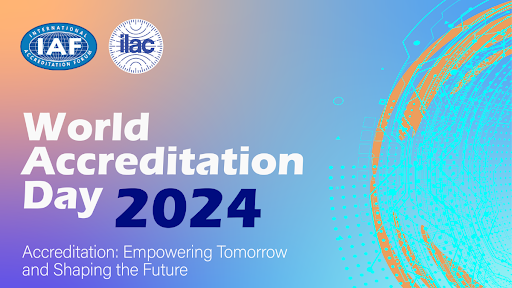Monday, 17th June 2024
New Economic Brain Power: India
Why in the news?
- Recent years, India has shifted from being primarily known as a provider of back-office services to becoming a pivotal intellectual hub for Multinational Corporations (MNCs).

Major Shifts in the Indian Economy due to the Rise of GCCs:
- From Back-Office to Strategic Partner:
- Historical Focus: In the 1990s and 2000s, India's global economic role centred around back-office functions such as telemarketing and data entry.
- Expansion into Complex Tasks: Today, India has expanded its role to encompass complex tasks including R&D, analytics, artificial intelligence/machine learning, robotic process automation, and product development.
- Skill Development and Talent Pool Evolution:
- Demand for Skilled Professionals: Global Capability Centers (GCCs) are driving the demand for skilled professionals, prompting a transformation in India's education and training systems.
- Educational Emphasis: Educational institutions are now prioritising STEM fields (Science, Technology, Engineering, and Mathematics), along with fostering critical thinking and problem-solving skills. These efforts aim to meet the evolving needs of GCCs.
- Innovation and Knowledge Economy:
- Role of GCCs: GCCs are not just executing tasks but are also emerging as innovation hubs for their parent companies, promoting a culture of research and development within India.
- Knowledge Transfer: The transfer of knowledge from MNCs to the Indian workforce enhances innovation, leading to the development of new technologies and solutions. This strengthens India's position in the global knowledge economy.
- Job Market Transformation:
- Creation of High-Paying Jobs: GCCs are generating high-paying jobs across diverse sectors beyond traditional IT services, attracting talent such as engineers, data scientists, and financial analysts.
- Career Prospects: The rise of GCCs improves career prospects for skilled professionals, contributing to an overall enhancement in living standards.
- Evolving IT Landscape:
- Technological Investments: The presence of GCCs is driving investments in advanced technologies like artificial intelligence, cloud computing, and big data analytics.
- Global Leadership: India's focus on cutting-edge technologies positions it as a leader in the global IT services market.
- Increased Global Competitiveness:
- Showcasing Capabilities: The growth of GCCs highlights India's capabilities on the global stage, with MNCs increasingly recognizing India's talent pool and cost-efficiency advantages.
- Attracting Foreign Investment: India's competitive edge is attracting more foreign investment, further bolstering its position in the global knowledge economy
What are Global Capability Centers (GCCs) ?
- About:
- Internal Entities: GCCs operate within the global corporate structure of MNCs, providing specialised capabilities such as IT services, research and development (R&D), customer support, and other business functions.
- Strategic Outposts: They serve as hubs for delivering crucial services and expertise while aligning with the parent company's global objectives.
- Examples of GCCs:
- General Electric (GE): Has a prominent GCC in Bangalore, focusing on R&D and engineering for its aviation and healthcare sectors.
- Nestle: Established a GCC in Lausanne, Switzerland, dedicated to product development and innovation for its food and beverage brands.
- Current Landscape:
- Market Size: As of 2022–23, there were approximately 1,600 GCCs globally, collectively constituting a market worth USD 46 billion and employing 1.7 million people.
- Growth Segments: Professional and consulting services within GCCs have shown rapid growth, outpacing sectors like computer services and R&D services.
- Advantages of GCCs:
- Cost Efficiency: Establishing GCCs in locations with lower operational costs allows MNCs to achieve significant savings.
- Operational Efficiency: GCCs streamline specific functions, enabling headquarters to focus on core business strategies.
- Market Insights: GCCs provide valuable insights into local markets, customer preferences, and regulatory landscapes, facilitating tailored business strategies for regional success.
Impact on Local Economies:
- Job Creation: GCCs create high-skilled jobs in host countries, contributing to economic growth and enhancing the local knowledge base.
- Knowledge Transfer: They promote knowledge transfer and technology adoption within the host country, fostering innovation and skill development.
- Foreign Investment Catalyst: By showcasing skilled workforces and favourable business environments, GCCs attract further foreign investment, bolstering the host country's economic ecosystem.
Conclusion:
Hence, the emergence of GCCs marks a profound evolution in India's global economic stature. Harnessing its intellectual capital, India is transitioning from a service provider to a pivotal strategic partner for MNCs. This transformation is set to exert enduring influence on India's economic advancement and reshape the global technology landscape.
|
UPSC Civil Services Examination, Previous Year Questions (PYQs) Prelims Q:1 With reference to Foreign Direct Investment in India, which one of the following is considered its major characteristic? (2020)
Ans: (b) Q:2 Consider the following: (2021)
Which of the above can be included in Foreign Direct Investments?
Ans: (a) Mains Q1. “The broader aims and objectives of the WTO are to manage and promote international trade in the era of globalisation. But the Doha round of negotiations seems doomed due to differences between the developed and the developing countries.” Discuss from the Indian perspective. (2016) Q2. What are the key areas of reform if the WTO has to survive in the present context of the ‘Trade War’, especially keeping in mind the interest of India? (2018) |
First All-India Survey on AYUSH
Why in the news ?
- Recently, the Ministry of Statistics and Programme Implementation (MoSPI) published the results of a national survey on Ayurveda, Yoga & Naturopathy, Unani, Siddha, and Homoeopathy (AYUSH) systems of medicine.
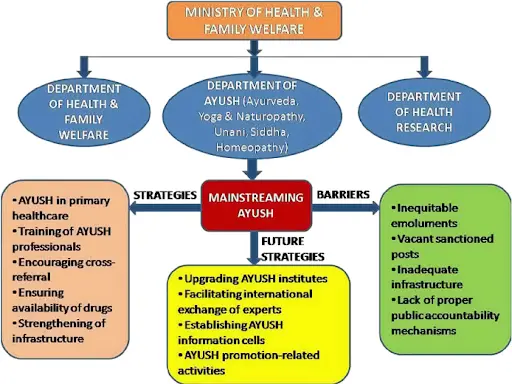
What are the Highlights of the Survey?
About:
- The recently concluded national survey on AYUSH conducted by the National Sample Survey Office (NSSO) from July 2022 to June 2023 marks the first comprehensive effort to capture utilisation patterns of traditional healthcare practices across India.
Objectives:
- Assess awareness levels among the population regarding the AYUSH system of medicine.
- Document the use of AYUSH for both preventive healthcare and treatment of ailments.
- Record household awareness of home remedies, medicinal plants, and local health traditions.
- Gather data on household expenditures related to treatments using AYUSH systems of medicine.
- Note: The survey covered the entire Indian Union, except for a few remote villages in the Andaman & Nicobar Islands.
Key Findings:
- Awareness of AYUSH:
- In rural India, approximately 95% of males and females aged 15 and above are familiar with AYUSH, while in urban areas, the awareness rate is around 96%.
- About 79% of households in rural India and 80% in urban India have at least one member knowledgeable about medicinal plants and home remedies.
- Around 24% of households in both rural and urban India have at least one member aware of folk medicine or local health traditions.

- Use of AYUSH:
- Approximately 53% of people in urban areas and 46% in rural areas have utilised AYUSH for prevention or treatment of ailments in the past year (365 days).
- Expenditure Incurred for Availing Treatment of AYUSH:
- The average expenditure per person for prevention or treatment of ailments using AYUSH was Rs. 574 in urban areas and Rs. 472 in rural areas.
- Use of AYUSH System by Purpose:
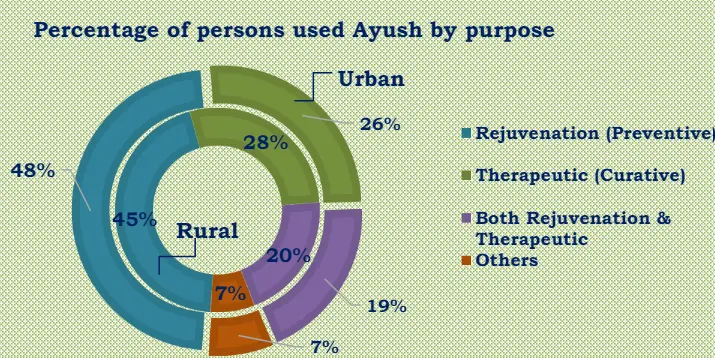
- Practice of Yoga:
- In rural India, approximately 11 million households, and in urban India, around 14 million households, have at least one member who practises yoga regularly.
|
AYUSH:
|
What are the Government Schemes Related to Promotion of AYUSH in India?
- National Ayush Mission:
- Launched in 2014 to promote traditional and cost-effective AYUSH systems of medicine in India.
- Focuses on infrastructure development, education, research, manpower augmentation, and quality control in AYUSH.
- Ayur Gyan:
- Aimed at promoting education, research, and innovation in AYUSH.
- Components include Capacity Building and Continuing Medical Education (CME) for AYUSH professionals, and Research & Innovation focusing on priority health areas.
- AYURSWASTHYA:
- Supports AYUSH organisations and institutes through grants to enhance facilities, research capabilities, and overall operations.
- Champion Service Sector Scheme:
- Aims to boost medical tourism in India, particularly in traditional medicine systems like Ayurveda and Yoga.
- Seeks to attract international patients, tourists, and visitors interested in AYUSH healthcare options.
- Promotion of International Cooperation in AYUSH:
- Focuses on raising awareness and interest in AYUSH systems globally.
- Aims to facilitate international promotion, development, and recognition of AYUSH practices.
- Ayush Oushadhi Gunvatta Evam Uttpadan Samvardhan Yojana:
- Aims to improve the quality and manufacturing standards of AYUSH medicines in India.
- Seeks to make these medicines safer, more reliable, and potentially exportable.
- Management of Medicinal Plants:
- Aims to promote cultivation, preservation, and sustainable management of medicinal plants.
- Led by the National Medicinal Plant Board under the Ministry of AYUSH to coordinate efforts across various ministries and departments for development.
|
Other Schemes Related to AYUSH:
|
|
UPSC Civil Services Examination, Previous Year Question (PYQ) Mains Q:1 How is the Government of India protecting traditional knowledge of medicine from patenting by pharmaceutical companies? (2019) |
ICIMOD, Report 2024 on Hindu-Kush Himalayan
Why in the news?
- According to the Snow Update Report 2024 from the International Centre for Integrated Mountain Development (ICIMOD), snow persistence in the Hindu Kush Himalaya (HKH) region was notably below normal levels this year.
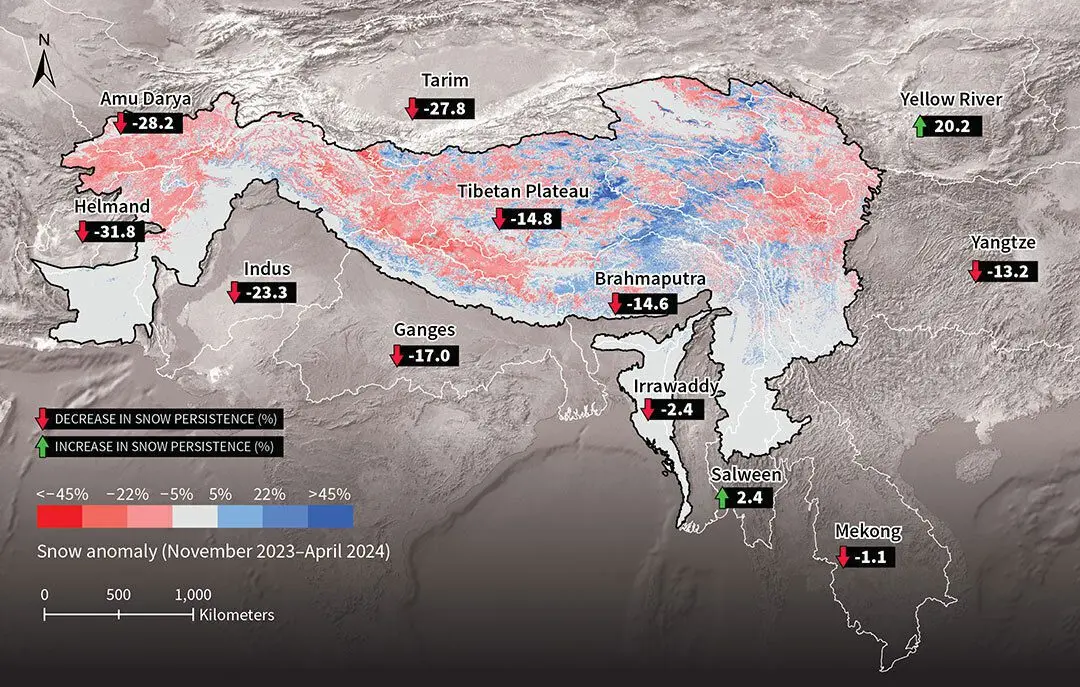
|
What about the ICIMOD ?
|
Key Findings of the ICIMOD Report:
- Comparison with Historical Records:
- The report analysed snow persistence in the Hindu Kush Himalaya (HKH) region from 2003 to 2024 and compared snow persistence in November 2023-April 2024 with historical averages.
- Below-average Snow Cover:
- The Indus, Ganga, and Brahmaputra river basins experienced reduced snow cover, with decreases of 23%, 17%, and 15% respectively compared to the average from 2003-2023.
- Dramatic Fall in Specific Basins:
- The Helmand River basin, originating from the HKH region and flowing into Afghanistan and Iran, saw a significant 31.8% decrease in snow persistence.
- The Amu Darya river basin, one of Central Asia’s longest rivers, experienced its lowest snow persistence with a notable 28.2% decrease below normal levels.
- Consistent Trend:
- Over the past 22 years, 13 have recorded below-average seasonal snow persistence in the HKH region, indicating a consistent trend of decreasing snow amounts and duration in 2024.
- Regional Trends:
- There is a gradient of decreasing below-average snow persistence from east to west across the HKH region, with the most pronounced declines observed in the western regions, where snow's contribution to water supply is significant.
- Implications for Water Security:
- Below-average snow accumulation poses a substantial risk to early summer water availability this year, affecting water security in the region.
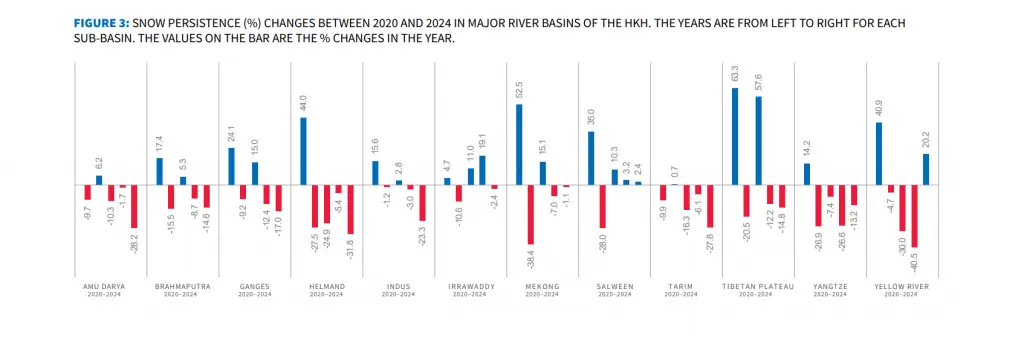
Way forward:
- Proactive Stakeholder Engagement:
- Stakeholders must take proactive steps to address challenges, mitigate potential water shortages, update plans to manage water stress effectively, and communicate risks to communities.
- Prompt Implementation of Drought Management Strategies:
- Governments need to swiftly implement drought management strategies to safeguard water resources and support communities during periods of reduced precipitation.
- Enhanced Water Management:
- Promoting rainwater collection for irrigation and other activities can significantly enhance water management practices, improving resilience to water scarcity.
- Collaborative Water Governance:
- Countries sharing transboundary rivers should collaborate to revise and strengthen water management laws, ensuring long-term resilience to climate change impacts on water resources.
|
About the Hindu Kush Himalaya Region:
|
|
UPSC Civil Services Examination, Previous Year Questions (PYQ) Prelims Q:1 When you travel in Himalayas, you will see the following: (2012)
Which of the above can be said to be the evidence for Himalayas being young fold mountains?
Ans: (d) Mains: Q.1 Briefly mention the alignment of major mountain ranges of the world and explain their impact on local weather conditions, with examples. (2021) Q.2 How will the melting of Himalayan glaciers have a far-reaching impact on the water resources of India? (2020) |
Source: DTE
India refuses to endorse Ukraine meet statement
Why in the news?
- Recently, India underscored that achieving peace requires proposals acceptable to both Russia and Ukraine, and therefore chose to disassociate from the final document issued on June 16 at the conclusion of the Peace Summit in Switzerland.
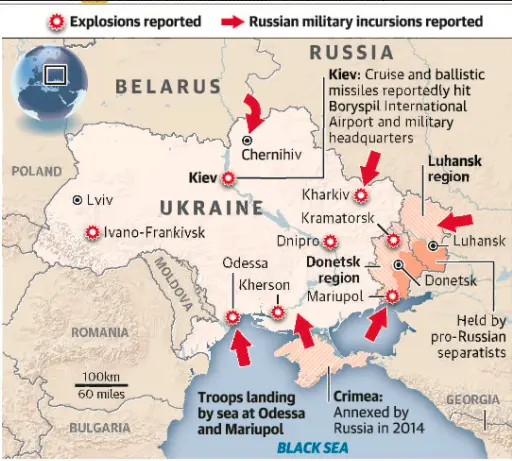
Key Highlights of the Ukraine Peace Summit in Switzerland:
- Attendance and Endorsement:
- More than 80 countries participated in the summit and endorsed the "Joint Communique on a Peace Framework."
- The communique emphasised the importance of protecting Ukraine's territorial integrity, based on Ukraine's peace formula and the principles of the UN Charter.
- Non-Endorsing Countries:
- India, Saudi Arabia, South Africa, Thailand, Indonesia, Mexico, and the United Arab Emirates did not sign the communique.
- Brazil attended as an observer, while China declined the invitation to participate.
- India’s Participation and Stance:
- India attended the summit but chose not to endorse the final document.
- India's stance is based on the principle that any peace proposal must be acceptable to both Russia and Ukraine for it to be sustainable.
- The Ministry of External Affairs (MEA) reiterated India's commitment to understanding diverse perspectives and pursuing a resolution through dialogue and diplomacy.
Why did India Refuse?
- Neutrality and Balanced Approach:
- India adheres to a policy of neutrality and balanced diplomacy in international conflicts.
- By abstaining from taking sides in the Russia-Ukraine conflict, India aims to maintain positive diplomatic relations with both nations.
- Emphasis on Mutually Acceptable Solutions:
- India believes that sustainable peace can only be achieved through proposals that are mutually acceptable to both Russia and Ukraine.
- This approach underscores India's commitment to promoting dialogue and practical engagement between the conflicting parties.
- Strategic and Diplomatic Considerations:
- By refraining from endorsing the communique, India preserves its potential role as a trusted mediator in international disputes.
- This stance helps safeguard its strategic partnerships, particularly with Russia, and takes into account broader geopolitical concerns such as food and energy security.
Conclusion:
Hence, India's decision underscores its commitment to neutrality, advocating for peace proposals acceptable to both Russia and Ukraine. It aims to preserve diplomatic relations and safeguard strategic interests amidst evolving global geopolitical dynamics.
|
UPSC Civil Services Examination, Previous Year Questions (PYQ) Mains Q: 1 What is the significance of Indo-US defence deals over Indo-Russian defence deals? Discuss with reference to stability in the Indo-Pacific region.(2020) |
Source: TH
DRDO developed Woman-led start-up : Divya Drishti
Why in the news?
- Recently, a start-up named Ingenious Research Solutions Pvt Ltd. collaborated with the Centre for Artificial Intelligence & Robotics (CAIR), a DRDO laboratory based in Bangalore, to develop an AI tool called ‘Divya Drishti.’

What is Divya Drishti ?
- About:
- ‘Divya Drishti’ integrates facial recognition with immutable physiological parameters such as gait and skeleton, creating a robust biometric authentication system.
- Biometric Authentication:
- This tool utilises both facial recognition and gait analysis, offering a dual-layered approach that enhances accuracy in identifying individuals and reduces the risks of false positives and identity fraud.
- Applications:
- ‘Divya Drishti’ has applications across various sectors including Defence, Law Enforcement, Corporate environments, and Public Infrastructure.
- Supported by:
- The development of this AI tool was supported by the Technology Development Fund (TDF), showcasing DRDO’s commitment to nurturing start-ups in the defence and aerospace sectors as part of the ‘Aatmanirbhar Bharat’ initiative.
|
Defence Research and Development Organization (DRDO):
|
Centre for Artificial Intelligence and Robotics (CAIR):
- About: CAIR, a prominent DRDO laboratory, specialises in research and development in Artificial Intelligence, Robotics, Command and Control, and Information and Communication Security.
- Role: CAIR plays a crucial role in influencing national technology policies, emphasising the importance of national security and fostering self-reliance in advanced technologies.
Source: IE
Olympus Mons
Why in the news ?
- Recently, water frost has been observed on the towering Tharsis volcanoes, including the massive Olympus Mons near Mars's equator, marking the first detection of such frost in this region.

About Olympus Mons:
- Olympus Mons is a shield volcano located in Mars' western hemisphere.
- It stands as the highest point on Mars and holds the title of the largest known volcano in the solar system.
- Rising to a height of 16 miles (24 kilometres), it towers approximately three times higher than Mt. Everest.
- With a diameter of 340 miles (550 kilometres), Olympus Mons covers an area larger than the entire Hawaiian Islands chain.
- By comparison, Earth's largest volcano, Mauna Loa in Hawaii, spans 120 kilometres across and reaches 9 kilometres in height.
- Olympus Mons is estimated to be around 3.5 billion years old, forming early in Mars' history.
- The volcano features a very gentle slope, ranging only between 2 to 5 degrees, giving it a remarkably flat appearance.
- At its summit lies a caldera, a large depression resulting from volcanic activity, which spans approximately 50 miles (80 kilometres) wide.
- This caldera is composed of several overlapping pits formed during different eruptive phases.
- In contrast, many Earth-based volcanoes typically exhibit a simpler, single caldera structure.
Why are the mountains so tall?
- Limited Plate Movement: Mars experiences minimal tectonic activity, with both the hot spot and crust remaining relatively stationary. This lack of movement allows lava to accumulate in one location, forming large volcanoes like Olympus Mons instead of volcanic island chains typical on Earth.
- Extended Lifespan: Martian volcanoes maintain continuous activity over millions of years, resulting in a steady accumulation of magma in specific areas on Mars' surface.
- Shield Volcano Type: Olympus Mons is a shield volcano, characterised by its gentle eruption style where lava flows slowly down its sides rather than erupting violently. This type of volcano contributes to Olympus Mons' broad, squat appearance with an average slope of only 5 percent.
Structural Features:
- Calderas: At the summit of Olympus Mons, six collapsed craters, known as calderas, are stacked on top of each other, creating a depression measuring 53 miles across.
- Outer Escarpment: Surrounding the volcano's perimeter is a cliff or escarpment that rises as high as 6 miles (10 km) above the surrounding terrain. This cliff alone matches the height of Earth's Mauna Loa volcano.
- Base Depression: The base of Olympus Mons is marked by a wide depression formed as the immense weight of the volcano presses into Mars' crust
Ephemeral Frost Discovered on Mars’ Olympus Mons:
- Ephemeral frost has been discovered on Mars' Olympus Mons, with approximately 150,000 tonnes of water cycling daily, according to findings from the European Space Agency's ExoMars Trace Gas Orbiter (TGO) NOMAD instrument.
- The frost was initially detected atop the Olympus Mons volcano by the ExoMars Trace Gas Orbiter's NOMAD instrument.
- The Mars Express orbiter further confirmed the unexpected presence of frost across multiple volcanoes in the Tharsis region.
- The frost patches are remarkably thin, about the width of a human hair, and cover extensive areas within the summit calderas of these volcanoes.
- This amount of frost translates to 150,000 tonnes of water exchanging between the surface and atmosphere each day during Mars' cold seasons, equivalent to 60 Olympic-sized swimming pools.
- The frost is transient, present for only a few hours around sunrise before evaporating in the daylight, highlighting unique microclimates within the deep volcanic calderas.
- Understanding the formation of this ephemeral frost provides insights into Mars' atmospheric dynamics and potential locations of liquid water, crucial for future robotic and human exploration missions.
|
Shield Volcano:
|
Source: ESA
Nagastra – 1
Why in the news ?
- Indian Army has received the 1st batch of man-portable suicide drones, Nagastra-1.
- The high-tech drones are designed and developed indigenously by Economic Explosives Limited (EEL), a subsidiary of Solar Industries, Nagpur.
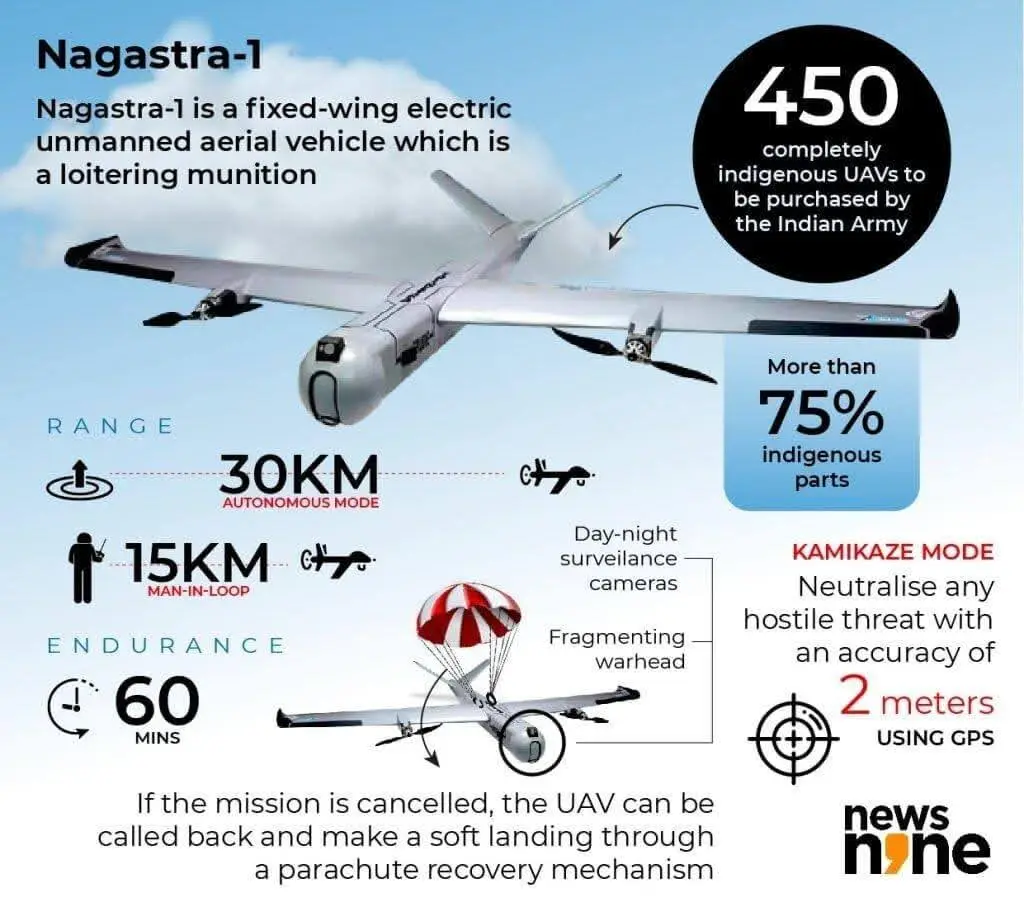
- Nagastra is a fixed-wing electric unmanned aerial vehicle with an endurance of 60 minutes.
- Unlike other weapons, Solar’s Nagastra has the capability to abort an attack if necessary and can be safely retrieved.
- It is named a loitering munition weapon due to its ability to hover over the target.
- It can carry a 1-kilo warhead and carry out a precision strike via GPS with an accuracy of within two metres.
- It offers a 15 km range with man-in-loop control and extends up to 30 km in autonomous mode.
- Due to its electric propulsion system, Nagastra-1 provides a low acoustic signature, making it almost undetectable at altitudes over 200 metres.
- It has a ‘Kamikaze mode’ in which it can search and destroy any target by crashing into it.
- It is equipped with day and night surveillance cameras.
- It has been designed to hit enemy training camps, launch pads, and infiltrators and thus reduce risk to soldiers.
Source: TOI
India's Journey to a Developed Economy
Context:
- India's journey to becoming a developed nation requires addressing fiscal and structural challenges, fostering inclusive growth, and strengthening the export sector.
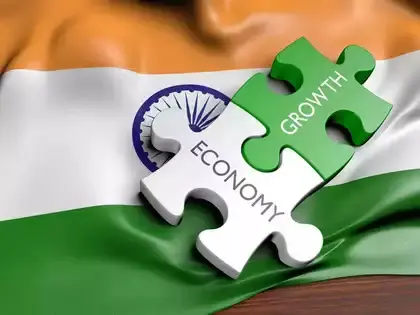
- India aims to become a developed nation by 2047, requiring a significant rise in per capita income from USD 2,600 to USD 10,205.
- This goal demands a 7.5% annual per capita income growth and a 9% GDP growth rate over the next 25 years.
What about the Developed Country?
- A developed country refers to a nation with a mature and advanced economy, characterised by high levels of industrialization, technological infrastructure, and overall societal well-being.
- The term "developed" distinguishes these countries from "developing" or "underdeveloped" nations, which are still undergoing economic and social growth.
- India, currently classified as a developing nation, is the world's fifth-largest economy with a GDP of 3.42 trillion USD.
Key Characteristics of Developed Countries:
- Economic Factors:
- High per capita income (typically above USD 12,000 to USD 25,000 or more)
- Diversified and advanced industrial and service sectors
- Robust infrastructure, including transportation, communication, and utilities
- Stable and efficient financial markets

- Social and Human Development Factors:
- High levels of education and literacy
- Access to quality healthcare and social services
- Low infant mortality and high life expectancy rates
- Robust legal and political institutions, with democratic governance
- Technological and Innovation Factors:
- Advanced technological infrastructure and capabilities
- Strong emphasis on research and development (R&D)
- High levels of innovation and productivity
Measurements and Indicators:
- Per Capita Income:
- One of the primary indicators used to determine a country's development status
- Calculated by dividing the Gross Domestic Product (GDP) by the total population
- Human Development Index (HDI):
- A composite index used by the United Nations to measure a country's overall well-being
- Factors include life expectancy, education levels, and standard of living
- Countries with an HDI score above 0.8 are generally considered developed
- Examples of Developed Countries:
- According to the International Monetary Fund (IMF), some developed countries include the United States, Canada, Japan, Australia, and New Zealand.
- Other examples include Singapore, South Korea, and Hong Kong in Asia.
The Major Growth Drivers Propelling India Towards a Developed Economy:
- Rise of the Services Sector:
- Significant Contribution to GDP: India's services sector contributes over 50% to the GDP, offering high-value jobs and attracting foreign investment.
- Global Leadership in IT and BPO: Industries like IT and Business Process Outsourcing (BPO) have made India a global leader, providing services to international clients and integrating the economy globally.
- Demographic Dividend
- Young Population: With a median age of 28.2 years (2023), India possesses a large pool of human capital that can drive economic growth if properly skilled and employed.
- Government Initiatives for Infrastructure Development
- Pradhan Mantri Gati Shakti National Master Plan: The Indian government's initiative aims to boost efficiency and economic activity across sectors through infrastructure development projects.
- Digital Transformation and Startup Ecosystem
- Digital India Initiative: India is undergoing a digital revolution with increasing internet penetration, facilitated by initiatives like the Unified Payment Interface.
- Thriving Startup Ecosystem: The country hosts a growing number of startups and research institutions, fostering innovation and creating new growth opportunities across various sectors.
- Economic Resilience Despite Global Slowdown
- Relative Domestic Demand Resilience: Despite global economic uncertainties and geopolitical tensions, India's domestic demand has shown resilience, with the RBI forecasting a 7% real GDP growth in 2024-25.
- Innovation and Entrepreneurship
- Cultural Embrace of Innovation: India is nurturing a culture of innovation and entrepreneurship, evidenced by the proliferation of startups and research institutions focused on developing cutting-edge technologies and solutions.
The Major Roadblocks to India’s Goal of Developed Economy:
- Jobless Growth:
- Despite India's impressive economic growth of 7.8% in FY 2023–24, it has not translated into sufficient job creation.
- A significant portion of the workforce remains entrenched in low-productivity agriculture, which contributes nearly 15% to GDP but employs 44% of the workforce.
- India needs to generate 115 million jobs by 2030 to accommodate its expanding workforce.
- Poverty-Education-Skill Trap:
- Poor quality primary and secondary education in India limits cognitive development and diminishes the potential benefits of higher education.
- This results in a workforce ill-prepared for higher-skilled jobs, contributing to a shortage of 150 million skilled workers.
- Despite the National Education Policy, the education system in India is slow to adapt to evolving industry demands, leaving many graduates without the specific skills sought by employers.
- High Public Debt:
- India's public debt stands at 81.9% of GDP, raising concerns about fiscal sustainability.
- The high debt burden necessitates high-interest rates, which crowd out private investment and impede economic growth.
- Vast Income Inequality:
- India exhibits high income inequality, with a substantial portion of the population living in poverty.
- In 2022-23, the top 1% of income earners captured 22.6% of national income, exacerbating income disparities and hindering inclusive growth and access to basic services for many.
- Rural-Urban Divide and Unbalanced Development:
- While India's urban centres have experienced economic growth, rural areas face persistent poverty, inadequate infrastructure, and limited access to basic services.
- Neglecting rural development deepens social disparities and poses risks of social unrest, which could impede overall progress.
- Climate Change Vulnerabilities:
- Rapid industrialization and urbanisation in India have led to environmental degradation, including air and water pollution, deforestation, and biodiversity loss.
- These environmental impacts not only affect public health and quality of life but also undermine the sustainability of economic growth.
- Failure to prioritise adaptation and mitigation measures could jeopardise India's development trajectory, with up to 4.5% of GDP at risk by 2030, according to the Reserve Bank of India.
- Infrastructure Deficit and Financing Challenges:
- India faces a substantial infrastructure gap, particularly in transportation, power, and urban infrastructure, which acts as a bottleneck to economic development.
- The infrastructure deficit is estimated at around USD 1.5 trillion, complicating efforts to spur economic growth.
- Challenges such as land acquisition, environmental clearances, and regulatory hurdles further delay infrastructure projects and contribute to cost overruns.
Measures can India Adopt to Accelerate Progression Towards a Developed Economy:
- Leveraging Demographic Dividend through Skill Development:
- India must heavily invest in vocational education, skill development programs, and apprenticeships to build a globally competitive workforce.
- Collaborating with industry to design curriculum aligned with market demands and emerging technologies such as AI, robotics, and renewable energy, drawing lessons from models like Norway's.
- Balanced Regional Development and Rural Transformation:
- Prioritise investment in rural infrastructure, including roads, electrification, healthcare, and digital connectivity, to bridge the rural-urban divide.
- Incentivize agro-processing units and manufacturing hubs in rural areas to create non-farm job opportunities.
- Promote sustainable agriculture practices, precision farming, and access to credit and insurance to enhance rural incomes and food security.
- Preventive and Affordable Healthcare:
- Increase public healthcare spending to at least 2.5% of GDP, as recommended by the National Health Policy 2017, to strengthen the healthcare system and improve Human Development Index indicators.
- Promote preventive healthcare through awareness campaigns, early detection, and lifestyle interventions.
- Utilise digital technologies like telemedicine to enhance healthcare access in remote areas and reduce costs.
- Innovative Infrastructure Financing and Public-Private Partnerships:
- Explore innovative financing models such as asset monetization and securitization of infrastructure assets, along with tapping into global capital markets.
- Promote infrastructure investment trusts (InvITs) and real estate investment trusts (REITs) to attract long-term institutional investors for infrastructure projects.
- Fostering Innovation and Technological Advancement:
- Increase R&D investment to 2% of GDP, in line with the Science, Technology, and Innovation Policy 2020 targets.
- Establish clean technology parks, incubation centres, and circular-economy zones to attract global technology leaders and foster innovation.
- Unlocking the Potential of the Blue Economy:
- Harness India's coastal resources through sustainable maritime activities like coastal shipping, marine tourism, offshore wind energy, and deep-sea mining.
- Develop infrastructure for ship repair, logistics hubs, and coastal economic zones to stimulate trade, employment, and economic growth.
- Promote marine biotechnology and value-added marine products to meet global demand.
- Formalising Informal Sector and Promoting Startup Hubs:
- Implement a portable social security system for informal sector workers to incentivize formalisation and job security.
- Establish well-funded startup hubs in Tier-2 and Tier-3 cities to foster disruptive innovation beyond major metros.
- Green Collar Jobs Revolution:
- Implement green jobs training programs in partnership with industries to prepare the workforce for roles in renewable energy, waste management, and sustainable infrastructure.
- Provide tax incentives and subsidies to companies hiring and training workers in green sectors, promoting job creation and sustainable development.
|
UPSC Civil Services Examination, Previous Year Questions (PYQs) Prelims Q:1 In the ‘Index of Eight Core Industries’, which one of the following is given the highest weight? (2015)
Ans: (b) Q:2 Increase in absolute and per capita real GNP do not connote a higher level of economic development, if: (2018)
Ans: (c) Q:3 In a given year in India, official poverty lines are higher in some States than in others because: (2019) (a) Poverty rates vary from State to State (b) Price levels vary from State to State (c) Gross State Product varies from State to State (d) Quality of public distribution varies from State to State Ans: (b) Mains Q.1 “Industrial growth rate has lagged behind in the overall growth of Gross-Domestic-Product(GDP) in the post-reform period” Give reasons. How far are the recent changes in Industrial Policy capable of increasing the industrial growth rate? (2017) Q.2 Normally countries shift from agriculture to industry and then later to services, but India shifted directly from agriculture to services. What are the reasons for the huge growth of services vis-a-vis the industry in the country? Can India become a developed country without a strong industrial base? (2014) |
Source: HT
Share the article
Edukemy’s Current Affairs Quiz is published with multiple choice questions for UPSC exams
MCQ
Get Latest Updates on Offers, Event dates, and free Mentorship sessions.

Get in touch with our Expert Academic Counsellors 👋
FAQs
UPSC Daily Current Affairs focuses on learning current events on a daily basis. An aspirant needs to study regular and updated information about current events, news, and relevant topics that are important for UPSC aspirants. It covers national and international affairs, government policies, socio-economic issues, science and technology advancements, and more.
UPSC Daily Current Affairs provides aspirants with a concise and comprehensive overview of the latest happenings and developments across various fields. It helps aspirants stay updated with current affairs and provides them with valuable insights and analysis, which are essential for answering questions in the UPSC examinations. It enhances their knowledge, analytical skills, and ability to connect current affairs with the UPSC syllabus.
UPSC Daily Current Affairs covers a wide range of topics, including politics, economics, science and technology, environment, social issues, governance, international relations, and more. It offers news summaries, in-depth analyses, editorials, opinion pieces, and relevant study materials. It also provides practice questions and quizzes to help aspirants test their understanding of current affairs.
Edukemy's UPSC Daily Current Affairs can be accessed through:
- UPSC Daily Current Affairs can be accessed through Current Affairs tab at the top of the Main Page of Edukemy.
- Edukemy Mobile app: The Daily Current Affairs can also be access through Edukemy Mobile App.
- Social media: Follow Edukemy’s official social media accounts or pages that provide UPSC Daily Current Affairs updates, including Facebook, Twitter, or Telegram channels.





